Are you considering investing in Adobe Analytics to understand and optimize your customers’ journey? With its advanced analytics capabilities, Adobe Analytics can provide invaluable insights to drive your marketing strategies. As a powerful analytics platform, it offers a range of pricing options and packages tailored to your needs. How much is Adobe Analytics? Let’s dive into Adobe Analytics pricing and compare it to competitors, so you can make an informed decision!
Key takeaways
- Adobe Analytics boasts a comprehensive suite of features distributed across three distinct pricing tiers—Select, Prime, and Ultimate.
- Comparing Adobe Analytics with competitors like Google Analytics and Woopra can help in determining the ideal analytics solution for your requirements and budget.
- Investing in Adobe Analytics provides advanced analytics tools and predictive insights that enable marketers to refine campaigns and improve customer experiences for improved business outcomes.
Understanding Adobe Analytics pricing
Adobe Analytics is a component of the Adobe Experience Cloud, a suite of solutions that enables businesses to deliver personalized customer experiences. It provides remarkable flexibility and customization options, making it a powerful analytics platform.
Factors affecting cost
The cost of Adobe Analytics is affected by several factors, such as data volume, features, and integrations. The effect of each feature on the price may not be readily apparent; however, examining Adobe Analytics pricing and plan packages can assist in determining the expense in relation to features and business needs.
Adobe Analytics offers pricing plans that range from as low as $2,000 to $2,500 per month for many companies. Larger enterprises seeking advanced analytics may invest over $100,000 annually. Despite the higher cost, Adobe’s strong reputation among businesses of all sizes justifies its value.
Pricing tiers
Adobe Analytics offers three distinct pricing tiers to cater to a range of business needs: Select, Prime, and Ultimate. The Select tier is designed to help organizations centralize their data, offering tools like drag-and-drop segment building to identify and optimize customer interactions. Moving up, the Prime tier provides a deeper understanding of customer behavior with the ability to act on insights in real time, enhancing the delivery of personalized experiences. At the top, the Ultimate tier expands capabilities even further by stitching together insights across channels into unified customer profiles, leveraging AI and machine learning to reveal hidden opportunities within the data.
Comparing Adobe Analytics packages
Adobe Analytics packages differ in terms of features and capabilities, catering to varying business needs. Each tier builds upon the previous, offering progressively more sophisticated tools for data analysis and customer engagement.
Adobe Analytics Select
Adobe Analytics Select is designed to help organizations centralize analytics data for more informed decisions, featuring drag-and-drop segment-building capabilities to help teams identify valuable customers and optimize interactions for growth.
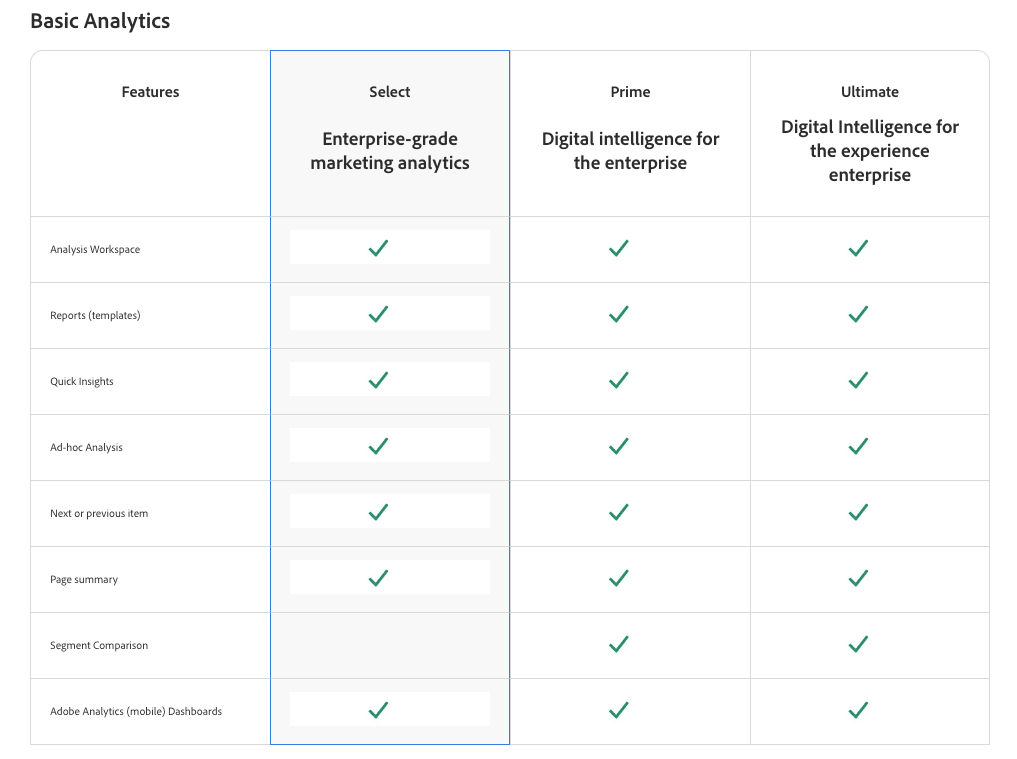
The Select package comes with all the journey visualizations and data sharing & democratization features of Adobe Analytics. It also covers all the basic analytics features except one—segment comparison. As for integrations, those who opt for the Select package are not at all at a disadvantage compared to those who choose the higher tiers.

Adobe Analytics Prime
Adobe Analytics Prime delivers real-time, cross-channel visibility to help marketers understand their customers, uncover new insights, and deliver personalized experiences that inspire action. It stands as a robust analytics solution designed for businesses intent on gaining a profound understanding of their customer base. It equips organizations with the ability to analyze customer data across various channels in real time, ensuring that insights are both comprehensive and actionable.
The Prime tier is particularly beneficial for marketers who need to deliver highly personalized experiences that resonate with customers and prompt immediate action, thereby fostering customer loyalty and driving business growth. With its advanced analytics capabilities, Prime enables users to not only interpret complex data but also to swiftly implement data-driven strategies that can significantly enhance the customer journey.
In addition to all the features available to Select, the Prime tier also fully covers all the audience segmentation features of Adobe Analytics.
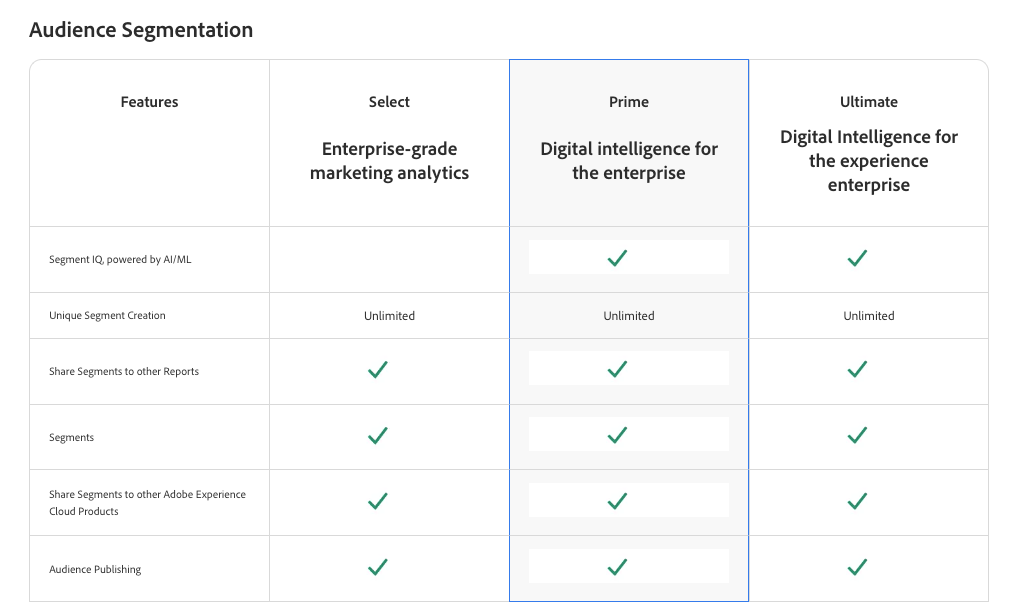
When it comes to augmented analysis using AI and machine learning, Prime-tier users have access to anomaly detection, contribution analysis, and intelligent alerts.
Adobe Analytics Ultimate
Adobe Analytics Ultimate provides a comprehensive solution for:
- Stitching together cross-channel insights to create unified customer profiles
- Gaining deeper insights into customer data
- Leveraging AI and machine learning to uncover hidden opportunities in data
- Utilizing Adobe Sensei, Adobe’s AI and machine learning platform, to provide predictive intelligence, deep insights, and enhanced creative expression
Adobe Analytics Ultimate represents the pinnacle of Adobe’s analytics offerings, providing an unparalleled depth of insight into customer data. This tier is engineered for enterprises that require a sophisticated understanding of their customer journey across multiple touchpoints, enabling the creation of detailed, unified customer profiles.
By harnessing the power of AI and machine learning, Ultimate goes beyond traditional analytics to predict future behaviors and uncover opportunities that would otherwise remain hidden within vast data sets. This predictive capability allows businesses to anticipate customer needs and preferences, delivering a highly optimized and individualized customer experience. Ultimate’s advanced features are designed to empower organizations to not only react to current trends but also to proactively shape customer interactions, driving innovation and maintaining a competitive edge in their respective markets.
While the lower tiers have limited access to data collection, data transformation, privacy & governance, and augmented analysis features, Adobe Analytics Prime fully supports them. From quick insights and cross-device analysis to retroactive data reprocessing and algorithmic attribution, Prime users have access to them all.
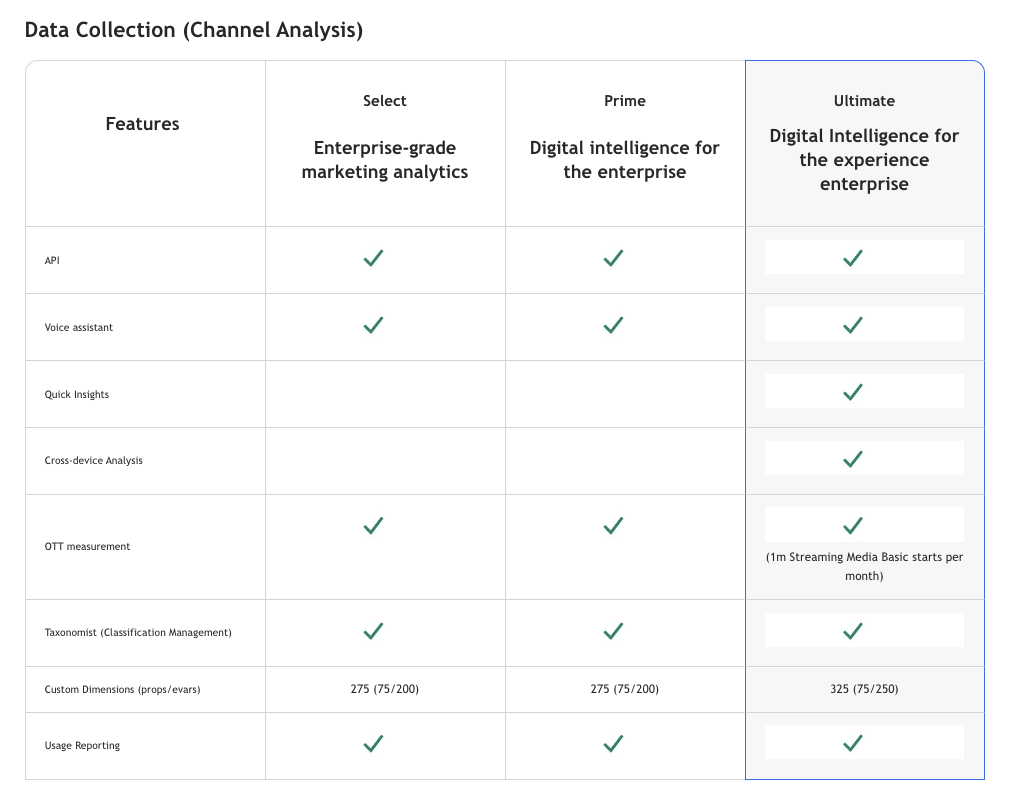
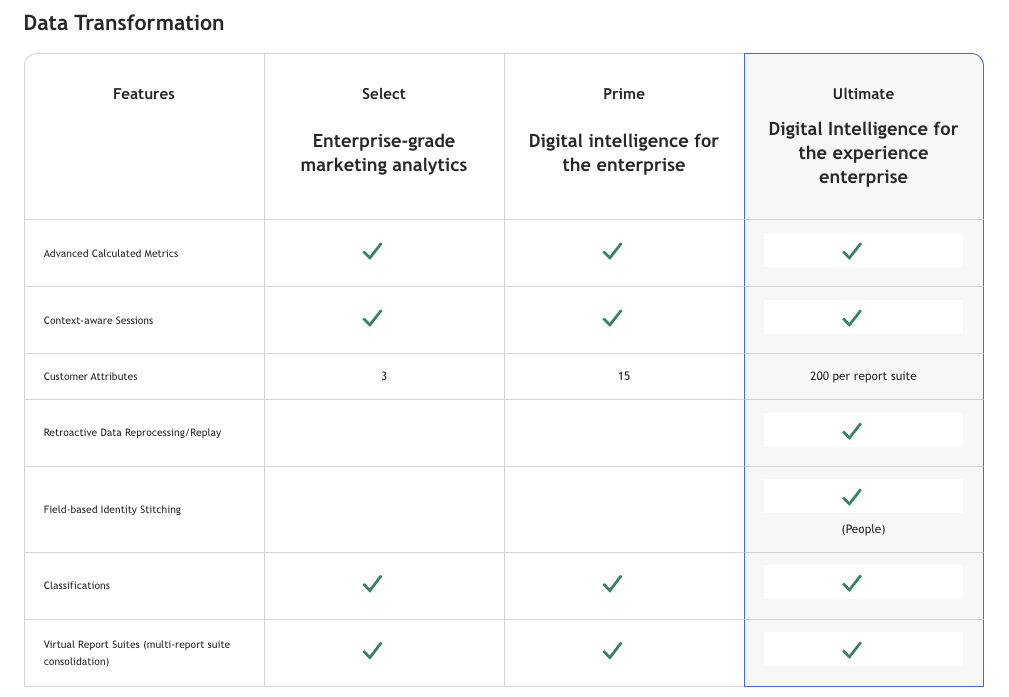
Customized solutions and add-ons
In addition to its standard packages, Adobe Analytics also offers customized solutions and add-ons to enhance its functionality. These include:
- Streaming media basic
- Streaming media advanced
- Live stream
- Customer journey analytics
- Data repair API
- Attribution AI
Custom Adobe Analytics packages
Custom analytics packages from Adobe offer several advantages in terms of advanced marketing insights, such as comprehensive data collection, multichannel data analysis, custom variables, and unique processing rules. They also facilitate real-time data gathering by providing real-time data collection and streaming capabilities.
The cost of Adobe Analytics’ custom packages may vary depending on the specific needs and requirements of the business.
Adobe Analytics add-ons
Adobe Analytics offers a variety of add-ons, such as the Common Analytics Plugins extension, Adobe Analytics Excel Add-In, and the Adobe Analytics Debugger for POST and GET requests. Add-ons can augment the functionality of Adobe Analytics in several ways.
The Common Analytics Plugins extension augments the Adobe Analytics extension and requires it to be installed on the user’s property. This extension enables the use of various plugins that can be initialized in their own rule to extend the functionality of Adobe Analytics. These plugins include actions such as obtaining geo-coordinates, distinguishing new vs. repeat visitors, identifying page names, responsive layouts, time parting, time since last visit, visit duration, and visit number.
Customer Journey Analytics is an add-on for Adobe Analytics that uses Analysis Workspace for robust data analysis. It can manage different data schemas and types using the Experience Data Model (XDM). This add-on allows the user to visualize and query years of data, offering improvements such as unlimited variables and events, the ability to change historical data, no limits on unique values, and the integration of data from multiple datasets. It provides tools for data manipulation and control. Customer Journey Analytics, when used with Adobe Experience Platform, allows for centralization and standardization of omnichannel data into a complete customer journey, offering real-time views and behaviors of customers.
Plugins offer additional functionality and can be easily installed through the Adobe Analytics extension. These add-ons broaden the capabilities of Adobe Analytics and enable more comprehensive insights and customization.
Adobe Analytics vs. competitors: Cost and feature comparison
Now, let’s compare Adobe Analytics’ costs with other competitors like Google Analytics and Woopra.
Grasping the price disparities among these analytics platforms can guide you in making an informed decision about the ideal solution for your organization’s needs and budget.
Adobe Analytics vs. Google Analytics
The cost discrepancy between Adobe Analytics and Google Analytics is substantial, with many potential users wondering about Adobe Analytics costs.
When it comes to web analytics tools, Adobe Analytics and Google Analytics stand out as industry leaders, each with its own cost structure and set of features. Google Analytics offers a free version, Google Analytics 4 (GA4), which provides robust app and web analytics, integrating machine learning to enhance data insights. This makes it an accessible option for small to medium-sized businesses or those just starting with analytics. On the other hand, Adobe Analytics does not have a free tier; it is a premium service with pricing that reflects its enterprise-level capabilities. While specific costs are not publicly listed and can vary widely depending on the services and scale required, Adobe Analytics is generally considered a significant investment, with costs that can start in the hundreds and extend to over $100,000 monthly for large-scale implementations.
Feature-wise, Adobe Analytics is often praised for its deep analysis capabilities, particularly in customer journey analytics, and its seamless integration within the Adobe ecosystem, which can be a decisive advantage for companies already using other Adobe products. Google Analytics, while less advanced in certain aspects, still offers comprehensive tools for tracking and analyzing website traffic and user behavior. Its integration with Google Ads and the broader suite of Google services makes it a powerful and cost-effective solution for many businesses. Ultimately, the choice between Adobe Analytics and Google Analytics will hinge on a company’s specific needs, budget, and the level of granularity required in their data analysis.
Adobe Analytics vs. Woopra
Woopra offers a free tier that includes core features and allows up to 500,000 actions per month, which can be quite advantageous for startups and small to medium-sized businesses. For more extensive needs, Woopra’s paid versions provide enterprise-level features at a cost generally lower than that of Google Analytics 360 or Adobe Analytics, making it an accessible option for companies with tighter budgets. Woopra’s data retention on the free plan lasts for 90 days, while premium plans offer longer retention periods.
While direct cost comparisons are challenging without specific details from Adobe, it is clear that Adobe Analytics is positioned as a more premium solution, potentially offering a more robust suite of analytics tools compared to Woopra.
Evaluating the return on investment
To evaluate if it is beneficial for your organization to invest in Adobe Analytics, considering the return on investment (ROI) is crucial.
According to a 2018 report by Forrester, using Adobee Analytics and Audience Manager can lead to significant performance improvements, such as a 21% increase in conversion rates across web and mobile, and a 10% increase in average order values by attracting higher value customers. These metrics indicate that Adobe Analytics can have a substantial positive impact on a company’s bottom line, which could correlate with higher revenue growth rates.
In the following segment, we will examine the advantages of investing in Adobe Analytics and methods to evaluate your business needs.
Benefits of investing in Adobe Analytics
Investing in Adobe Analytics offers numerous benefits, such as advanced analytics tools, predictive analytics, and user behavior tracking. Adobe Analytics leverages machine learning algorithms to provide insights and forecast trends, enabling marketers to refine and improve campaigns. By analyzing streams of data and converting them into actionable, real-time insights, Adobe Analytics enables data-driven decisions and improved audience targeting, ultimately improving customer experiences and the bottom line.
Adobe Analytics provides valuable customer insights that enable businesses to:
- Gain an in-depth understanding of their customers’ journeys across various channels through marketing analytics
- Track customer engagement, analyze patterns and changes over time, and identify trends that can inform marketing and product strategies
- Access real-time data and comprehensive customer profiles
- Create custom reports and make data-driven decisions based on cross-channel insights
Assessing your business needs
In determining the suitability of Adobe Analytics for your organization, it is crucial to bear in mind factors such as scalability, compatibility with your industry, capabilities for data analysis, options for customization, and performance optimization. By recognizing and organizing your business requirements, you can opt for the package that is most suitable for your particular requirements and objectives. Adobe Analytics features can address your business needs through the collection and measurement of data, customization, data analysis, real-time reporting, and advanced segmentation.
Adobe Analytics provides the following benefits:
- Personalized experiences
- Data science for informed decision-making
- Customer journey understanding
- Real-time insights
- Customization and adaptability for various business models and industries
By carefully evaluating your organization’s needs and requirements, you can determine whether Adobe Analytics is the right choice for your business and ensure a successful implementation that drives results.
Summary
Adobe Analytics is a powerful analytics platform with a range of pricing options and packages tailored to your needs. By understanding the factors that affect its cost and comparing it to competitors like Google Analytics and Woopra, you can make an informed decision about the right analytics solution for your organization. Don’t forget to evaluate the return on investment and assess your business needs to ensure that Adobe Analytics aligns with your organization’s goals. With the right analytics tool in place, your business can unlock valuable insights, optimize customer experiences, and drive revenue growth.
Frequently Asked Questions
Is Adobe Analytics free or paid?
Adobe Analytics is a paid service, with the pricing depending on several factors, such as the specific features required, the level of customization, the volume of data processed, the number of users, and the length of the contract. Smaller companies could pay as low as $2,000 – $2,500 a month, while larger businesses could spend upwards of $100,000 a year.
Is Adobe Analytics better than Google Analytics?
The choice between Adobe Analytics and Google Analytics depends on your needs. If you’re looking for an analytical tool for marketing purposes, Google Analytics will do the job. For more in-depth insights and AI-driven reports to personalize user journeys, Adobe Analytics is the better option.
How much is Google Analytics vs Adobe Analytics?
Google Analytics is free, making it a more cost-effective option compared to Adobe Analytics, which can cost over $100,000 annually. Nonetheless, for enterprises in need of more advanced tools, Adobe Analytics might be the preferred choice because of its extensive capabilities in integrating customer data.
What factors affect the cost of Adobe Analytics?
Costs for Adobe Analytics are largely affected by data volume, features utilized, and the number of integrations implemented.
Unlock the power of Adobe Analytics to elevate your data insights and drive smarter business decisions. Interested in advancing your analytics? Contact us to explore the possibilities with Adobe Analytics.
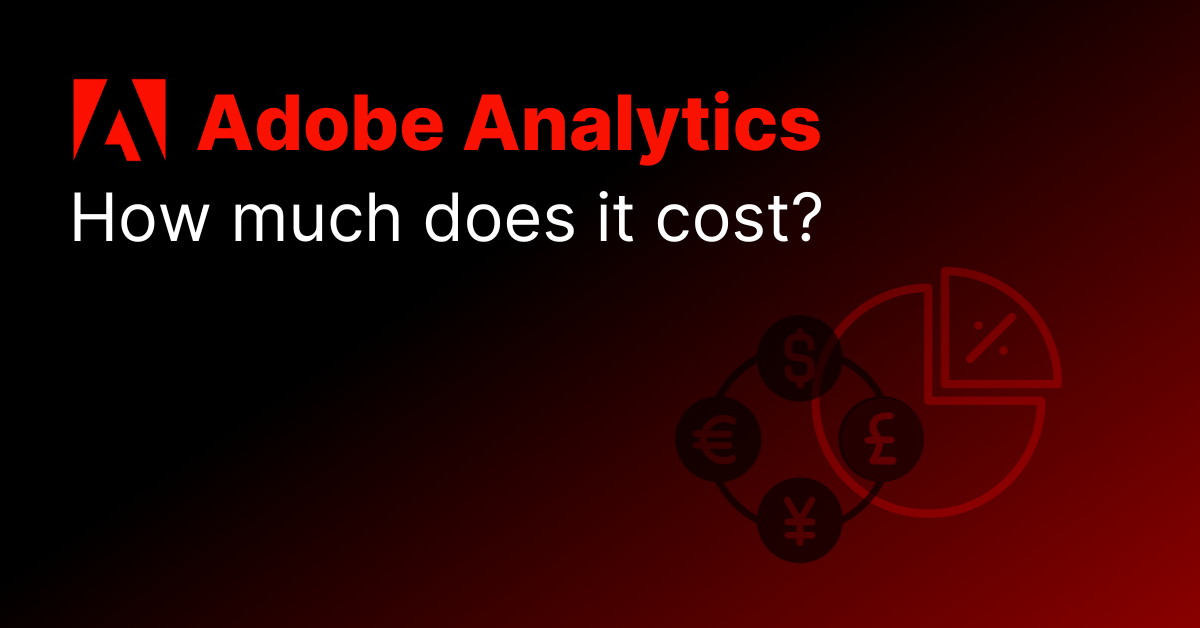

Share on: